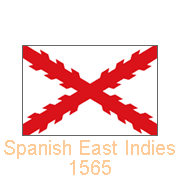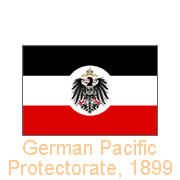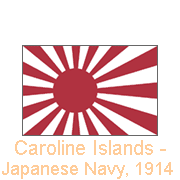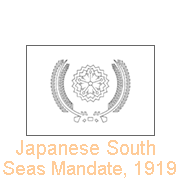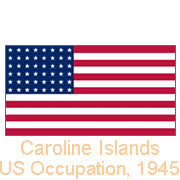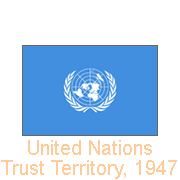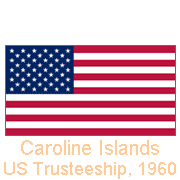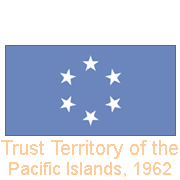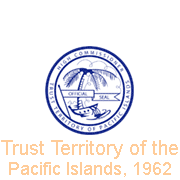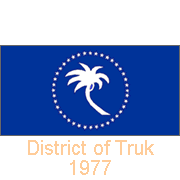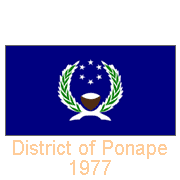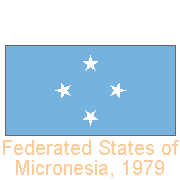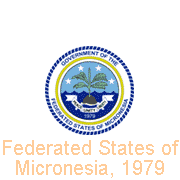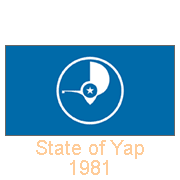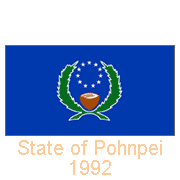Flags from Micronesia
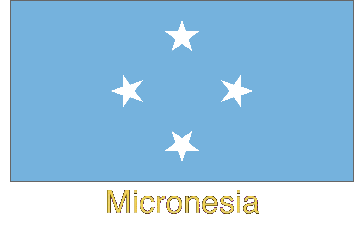
Flag History of the Federated States of Micronesia
In 1565 Spain had claimed sovereignty over the islands they later called the “Caroline Islands” and controlled the “Spanish East Indies” from Manila, in the Philippines. From 1506 to 1701 Spain used a naval ensign with, on a white field, the “Cross of Burgundy”. It represents the cross in which Saint Andrew was crucified: two crossed, roughly-pruned knotted branches. A red-yellow-red triband, the yellow band twice as wide as the red ones, was chosen in 1785 as a naval ensign. It featured the coat of arms of Castile and Leon, surmounted with a crown and became the National flag in 1843.
you may then send it as a postcard if you wish.
By the German–Spanish Treaty of 1899, Germany bought the islands from Spain and administered them from German New Guinea. Its flag was the black-white-red flag of the German Empire with the coat of arms on a white disk. It featured the Imperial Eagle surmounted by a crown and wearing a breast shield with the Prussian Arms. But in 1914, at the start of the First World War, the Japanese Navy seized the islands, flying the Japanese Naval Ensign: the Rising Sun with 16 rays, in red on a white field. In 1919 Japan was given a mandate by the League of Nations to govern them. The terms of this mandate specified that the islands should be demilitarised and Japan should not extend its influence further into the Pacific. But by late 1920 Japan refused requests for inspection and by 1935 it had withdrawn from the League of Nations. The flag of the mandate showed a stylised emblem surrounded by a laurel wreath, in black outline on a white field.
During the 1930s Japan had constructed airfields, fortifications, ports, and other military projects in the islands they controlled and these became important staging grounds for Japanese air and naval offensives in the Pacific War. The United States military subjected some fortified islands to amphibious assault, some only to air attack and bypassing others, causing the Japanese to lose control from 1943 onwards. When Japan finally surrendered on 15 August 1945, the islands were under American occupation. They flew the Stars and Stripes flag: thirteen alternating red and white stripes and 48 white stars on a blue field in the canton, representing the number of states in that year. In 1960 the number of states became 50, and the US flag changed accordingly.
On 18 July 1947, the islands were designated a United Nations Trust Territory under United States trusteeship. The UN flag, adopted on 7 December 1946, shows its emblem in white on a light blue background: a map of the world centred on the North Pole, surrounded by olive tree branches, a symbol for peace; the map represents all people and countries of the world. In 1962 a flag was adopted for the Trust Territory, featuring a circle of six white stars on a light blue background: the colours of the United Nations flag. The stars stood for the districts of Palau, Yap, Truk (now Chuuk), Ponape (now Pohnpei and including Kusaie, now Kosrae), the Marshall Islands and the Northern Marianas.
In April 1976 the Northern Marianas left the federation, and in 1979 both the Marshall Islands and Palau voted against joining the Federated States of Micronesia. In January 1977 the island of Kusaie, now Kosrae, became a separate district from Ponape (Pohnpei). On 10 May 1979, four of the Trust Territory districts ratified a new constitution to become the Federated States of Micronesia. They adopted a new flag, now with four stars, representing Pohnpei, Kosrae, Chuuk and Yap. An Official Seal was designed, and the four States eventually also had their own flags. Truk (now Chuuk) and Ponape (now Pohnpei) already had adopted flags before independence; their designs were slightly changed afterwards.


